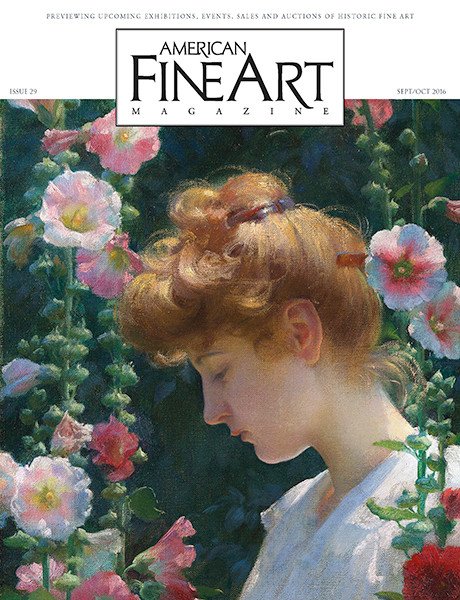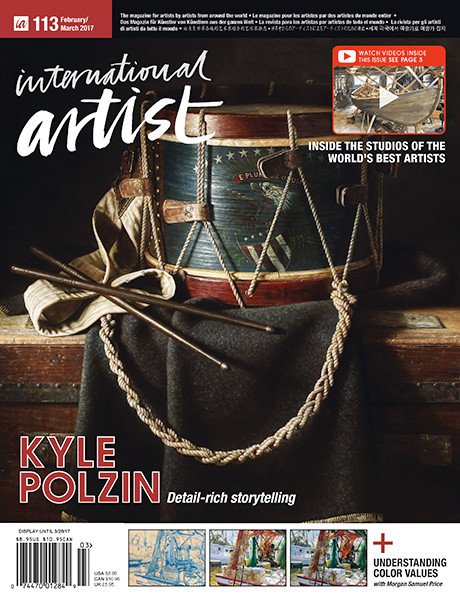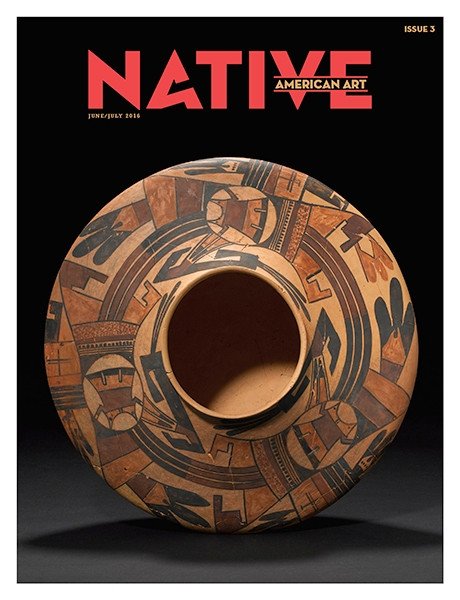For G. Russell Case, painting is more than an artistic pursuit. It’s a way of participating in something larger than himself. “There’s purpose and beauty in the landscape, and if something is beautiful, that points to something—or someone—who defines that beauty,” he says. In his paintings, Case captures the monumental scale of the American West while still maintaining a sense of wonder and humility.
And while his paintings have now earned him recognition across the Western art world, Case started off his artistic career in a smaller setting: a makeshift studio in his childhood home.

The Ramrocks, 2025, oil, 30 x 40 in.
“I’d always been interested in drawing, especially when I was younger,” Case says. His father was an accomplished watercolor painter and collector, giving him early exposure to the arts, but Case didn’t start thinking about becoming a painter until he was a sophomore in high school. “We had a graduate student from the local university come give us a presentation, and it just clicked. I went home and asked my dad, ‘Can I paint?’ And he set me up with a studio in the house and from there, I just took off.”
After Case started painting more seriously, having an artist for a parent came in handy. “My dad knew how to help me. He knew what kind of materials I’d need, how to frame things, that sort of thing,” he says. “He’d line up opportunities around town and I sold a few paintings that way.” The experience gave him a better understanding of how to build a career as an artist—how to go from creating something to sharing it with others.

Dry Season, 2024, oil, 30 x 40 in. Private collection.
Case went on to pursue formal arts training at Utah State University. “I had great instructors there—strong painting and drawing programs, excellent life drawing, printmaking, and I even had the opportunity to study with one of the best watercolorists around, Galen Strickland,” he says.
But as he approached graduation, he found himself at a crossroads, unsure whether he would pursue a full-time career as an artist. One night, he was helping his painting professor, Harrison Groutage, with some work around the studio, when Groutage asked him what he planned to do after graduation. “I told him I’d probably get a master’s degree and teach somewhere,” Case remembers. “He said, ‘Why would you do that? You should paint for a living.’ And that conversation ended up really shifting my perspective.”

Cloud, 2025, oil, 30 x 24 in.
While the education Case received was well-rounded from a technical perspective, one downside was that it was focused on the past. “We learned about what came before. The important movements. I knew about the French impressionists and the Old Masters, but I didn’t know very much about American painters or how to make a living as an artist,” he says.
Late in his education, a new teacher introduced him to the work of Edward Hopper, which sparked a deeper interested in American painters. “I was fascinated,” he says. “I was already painting in a similar style, so I dove deeper, learning about Robert Henri and the Ashcan School—all these American painters pushing against the grain.” This, in turn, led him to Western American painters like Maynard Dixon, and suddenly, the threads of historic art movements began to connect to his understanding of his own painting style. “It was a really pivotal moment for me in finding my own direction.”

Sage Rider, 2024, oil, 20 x 24 in. Private collection.
He sought out workshops with Western artists working in the field, including Matt Smith and Skip Whitcomb. “I was also highly influenced by Len Schmiel, Tim Lawson and George Carlson,” he says.
When asked about how his style has evolved over time, Case pauses. “I think that’s a tough question,” he says. “Sometimes people say, ‘This looks like a Russell Case painting,” and I think, ‘What does a Russell Case painting even look like?’”
For him, the process of painting is tied to striving for improvement, grasping for an ideal that is just out of his reach. “I always have something in mind when I start, but it never quite materializes the way I imagine,” he says. “Viewers only see the final product, and they don’t know that it’s never exactly what I was aiming for.”

Bluff Cliffs, 2025, oil, 16 x 20 in.
Still, he recognizes that his work has become more refined and simplified over time. “I’m more focused now on the essence of what I’m trying to convey, whether it’s mesas, clouds or the jagged peaks behind my house.” He’s interested in editing, removing the noise and distilling the image down to what matters most. “As painters, we can choose to leave things out. I aim for simplicity and direction, getting straight to the mood, composition or colors I want to express.”
His painting process starts in the field and ends in the studio. “I go out and draw and paint on location,” he says. Field studies are critical because they capture life and interesting detail that cameras often elide. Being on location can be a challenge, he says, because things change constantly. “Out in the field, there are no edges. You have to decide what to include and what to leave out.”
Once Case is back in the studio, he can take a step back, piecing studies and references together to build a bigger, more complete work. “That’s where the creativity comes in. You can ask, ‘What if?’ and push the scene in new and interesting directions.”

Clouds and Juniper Hills, 2024, oil, 24 x 30 in.
Case is currently preparing new paintings for a show at Maxwell Alexander Gallery in Pasadena, California. “I’m really grateful to Maxwell Alexander Gallery for giving me a shot and promoting my work,” he says. “As an artist, it means a lot to have someone willing to hang your work and support what you do.”
The show will include works that continue his exploration of desert landscapes. “I’m definitely a desert guy,” he says. “I love the contrast of planes rising vertically. The canyons, the mesas, the mountains.” Case finds the dramatic light and shadow of the desert in the early morning or late evening especially captivating. “You get those long shadows and rich contrasts that make the desert come alive.”
“I really enjoy taking an idea and exploring it across several paintings, increasing the size, adjusting elements, and refining it into a polished, large-scale work,” he says. Sometimes, this iterative process gives Case a fresh perspective on his older works. “I will pull out old pieces, see them in a new light, and finish them up.”

G. Russell Case in Bluff, Utah, during an artist retreat in 2021.
He’s especially excited about some big sky paintings that are in the works. “Dramatic clouds, big mesas, deep shadows. Those are really speaking to me right now.” His approach to painting skies is both similar and different to his approach to painting land features. He explains, “Skies are softer. Clouds are mostly reflected light, so they have different edges and different forms.” But in the end, it’s still about capturing a form in space, just with a softer touch.
Whether he’s capturing the wide expanse of a desert sky or the sharp edge of a mesa, Case’s work invites viewers to slow down and experience the beauty and scale of nature. “I often paint big landscapes with small figures to emphasize that scale,” he says. “It’s to remind us that we’re part of something much bigger.” —
Color & Silence
Opens May 17, 2025
Maxwell Alexander Gallery
1300 N. Lake Avenue, Pasadena, CA 91104
(213) 275-1060 www.maxwellalexandergallery.com
Powered by Froala Editor





















































